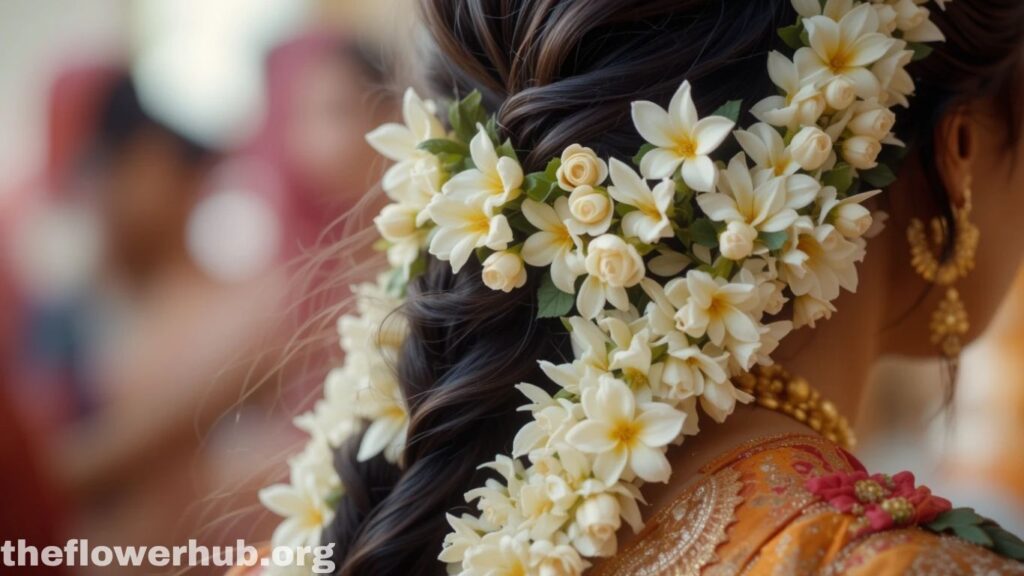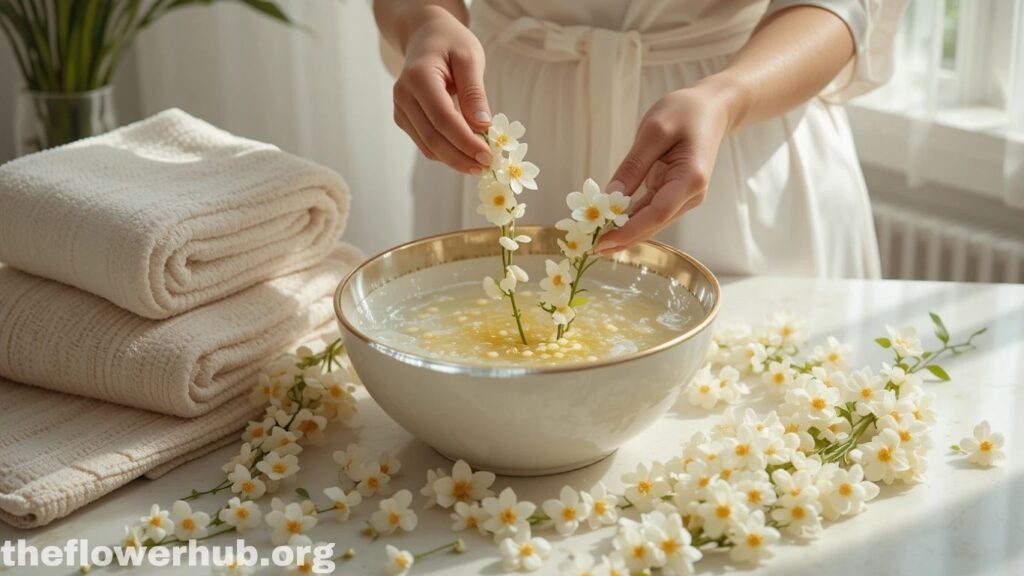Introduction
The Gajra flower has a predominate place in the colourful fabric of South Asian culture, particularly in India and Pakistan. This traditional flower arrangement is prepared by the women for their hair, to smell like it’s a blossom of grace. It’s more than just an ornament; it’s a symbol of beauty, rejoicing and cultural heritage. Whether it has entwined the tresses of a bride or added a decorative halo around the head of a dancer, the gajra flower has withstood the passage of time with its ageless allure.
In this comprehensive guide post, you will learn about 7 interesting facts about the gajra flower, its history and culture, different types, eventful & everyday uses, the process to make and maintain it, so much more! Let’s dive in.

Table of Contents
Table: Quick Overview
| Aspect | Details |
|---|---|
| Common Name | Gajra Flower |
| Popular Flowers Used | Jasmine (Mogra), Rose, Marigold, Tuberose (Rajnigandha) |
| Cultural Significance | Weddings, religious ceremonies, classical dance, occasions |
| Primary Usage | Ornament on hair, bracelets, and garlands |
| Key Regions | India, Pakistan, Sri Lanka, Bangladesh |
| Symbolism | Femininity, purity, beauty, and dedication |
| Life Span | 1–2 days (fresh), weeks (artificial) |
Gajra Flower: A Cultural Treasure Passed Down Generations
“Not just a pretty floral accessory, the gajra flower. It is something heavily laden with cultural symbolism. It is traditionally worn by women of South Asia (particularly India) on special occasions such as weddings and signifies beauty and commitment. The term “Gajra“ itself stands for a string of flowers tied together into a garland which is generally used in hairs.
In traditional dance styles like Bharatanatyam and Kathak, the gajra adds to the beauty of the dancer and represents beauty and grace. In weddings and religious functions, gajra is worn by women of every age group as a symbol of good luck.
The gajra has left its imprint on ordinary daily life, too. In Several parts of India, especially in South India, ladies use jasmine gajras daily, some to temples and some with their daily apparel. It’s not just a cosmetic accessory, but also a comforting aroma.
Varieties of Gajra flowers according to different occasions
Gajras are made with various flowers based on the season, the territory and the event. The most popular and widely used flower is the Jasmine, with its heady perfume. But there are also others such as Rajnigandha (Tuberose), Roses, and Marigolds.
Popular Gajra Flower Types
- Jasmine (Mogra): It’s sweet exotic fragrance is the most popular.
- Rajnigandha (Tuberose): Because the fragrance is forever with a touch of class!
- Rose Petals: They are bright and are so romantic in symbolism.
- Marigold: The bold pattern is also considered festive and ideal for religious gatherings.
Every flower has its own mood and aesthetic. For instance, Jasmine gajras are subtle and romantic, Marigold gajras are bright and merry.
Gajra Flower in Weddings and Festivals
Gajra Flower in Wedding Traditions
The gajra flower is an important decoration in Indian and Pakistani weddings. The bride adorns a gajra of jasmine flowers around her bun and even guests and bridesmaids to not shy away from using them as a piece of traditional clothing.
Haldi: It is the time when floral jewelry adorns the bride, particularly with gajras of fresh jasmine.
Mehndi Ceremony: Just as Mehndi ceremony itself is a very colourful and vibrant function so can be the flowers and we don’t even have to tell you what flower gajras and flower bracelets can do to the outfit.
Reception Looks: In reception looks, some brides add gajras to their classic buns or braids for a princely look.
Festivals Featuring the Gajra Flower
Gajras are widely used during festivals such as Diwali, Eid, Raksha Bandhan, Onam etc. Ladies adorn themselves in traditional attire and complete their look with a sweet smelling Gajra representing happiness & spirituality.
In South India, adorning a jasmine gara daily is believed to be a tradition and mark of women. It’s part of morning rituals and visits to the temple.
How to Make Gajra Flower at Home
Specialized pre-made flowers work (see here), but building your own gajra is surprisingly easy and supremely satisfying.
DIY Gajra Flower with Step by Step Instruction
Materials Needed:
- Fresh jasmine or fragrant flower of your choice
- White cotton twine or wire for flowers
- Scissors
- Optional: Hairpin or rubber band
Instructions:
- Pick Fresh Blossoms: Use flowers with full blooms and sturdy stems.
- Trim the Stems: You want to leave about 1-2 inches of stem.
- Fish the Flowers: Use a needle or simply tie the flowers one by one in a circle or in a straight line.
- Fasten off: Tie off the thread securely and attach it to a hairpin or rubber band.
Creating a gajra at home, allows you to feel more connected with the tradition and also add personal touch to your styling.
Gajra in Classical Dance and Cine Industry
Cultural Significance in Performing Arts
In India, the gajra flower is popular among traditional dance forms. Dancers wear it as part of the costume in Bharatanatyam, Mohiniyattam, Kuchipudi and Kathak.
It is designed for head shaking and can make an ethnic look perfect.
Bollywood And Gajras, A Ever Flowing Love!
The gajra has sashayed its way through numerous Bollywood movies – right from the days of the golden classics to the films of today. But think of iconic heroine(s) like Madhubala, Hema Malini or Madhuri Dixit, and you’ll remember the romantic scenes with jasmine gajras pinned behind the ears. Gajras are a timeless choice for cinema, these are symbols of feminity and attractiveness.
Even present-day actresses have kept the tradition alive by donning them in period films and music videos – proving that gajras are eternally in vogue.
Artificial vs. Real Gajra Flower: Pros and Cons
Real vs. Artificial – Which Gajra Is Right for You?
| Feature | Real Gajra Flower | Artificial Gajra Flower |
|---|---|---|
| Fragrance | Only natural and fresh | None or artificial |
| Longevity | 1-2 days max | Weeks or even months |
| Cost | Moderate (daily) | One-time higher cost, long-term saving |
| Cultural Authenticity | 100% traditional | Looks almost alike but without fragrance |
| Availability | Seasonal | Available all year round |
Nothing can beat the real gajra flower if you’re looking at authenticity, particularly in the case of weddings or religious functions. But when it comes to everyday wear or fashion shoots, artificial gajras allow for versatility.
Care Instructions for Gajra Flower
Whether you have a fresh gajra or an artificial one, a little taking care, and they’ll last longer and look better.

How to Care for Real Gajra ka Phool
- Refrigerate: Store it wrapped in a slightly damp cloth or a paper towel.
- Keep Out of the Sun: Especially when you about to wear it.
- Water Sparingly to Keep Fresh: Spritz gently with water.
Maintenance of Artificial Gajras
- Regularly Dust: Use a soft cloth or brush.
- Storage: Store in a dry, airtight box.
What’s Poppin’: Gajra Flower in the Fashion of Today
Now-a-days, gajra flowers are also being used by these stylists and designers in modern avatar. From fashion weeks to luxury bridal shoots, the gajra is explored in fusion looks.
- Gajra Crowns: For a boho-meets-ethnic bridal vibe.
- Gajra Earrings A trending Mehndi look.
- Gajra braids: Gajras are worn by many modern brides on their Indo-western hairstyles.
Gajra has also been a muse for accessories beyond flowers – embroidered motifs, prints on fabrics, even gold jewelry in gajra patterns.
Varieties of the Gajra Flower Tradition by Region
Gajras made with jasmine flowers is an everyday matter down south. In North India, they use them more in festivals and weddings.
Among the people of Maharashtra, “veni” (garland for hair), are paired with saree sarees such as Paithani. In Tamil Nadu, Kerala, and Karnataka women wear gajras with traditional kanjeevaram or kasavu sarees.
The tradition also extends to Nepal, India and Bangladesh where people wear similar type of flower garlands with regional clothes.
FAQs
Q1. What is a gajra flower made out of normally?
The most classic gajras are composed of jasmine (mogra) flowers, which are chosen for their heady scent and swing as weddings hold significance.
Q2. How do I prepare gajra flowers at home?
Yes! You can make a plain gajra right in your home, using fresh flowers, threads and scissors.
Q3. How long does a real gajra last?
Fresh gajras usually have a shelf life of 1-2 days if stored in a cool place.
Q4. Is it acceptable to use an artificial gajra even in cultural sense?
Although real flowers are the preferred option for authenticity, artificial gajras are also being used for casual or photographic use.
Q5. When can I wear a gajra flower?
Whether it is your wedding, festival season – Diwali or Eid, religious event, or even a classical dance performance, there could be no better occasion to wear a gajra.
Q6. Is use of gajra flower restricted to India only?
No. It also spread throughout Pakistan, Sri Lanka, Nepal and Bangladesh with regional variations.
Conclusion
But the gajra is not just an accessory – it’s an olfactory emblem of beauty, agreed-upon custom and joy that’s been handed down through generations. Be it fresh, be it artificial; jasmine, rose, it’s an emotional and cultural tie to heritage.
From the bridal dose to the feasting on the festivals, from Bollywood beauty to temple dancing – the enthusiasm still flows and allurement of the gajra flower has not yet tamed. Adopting this age-old tradition in contemporary methods does not only help retain cultural identity but also makes one feel closer to its roots.
So next time you put a gajra in your hair, remember you’re not just wearing flowers. You are also wearing history, heritage, timeless beauty.
